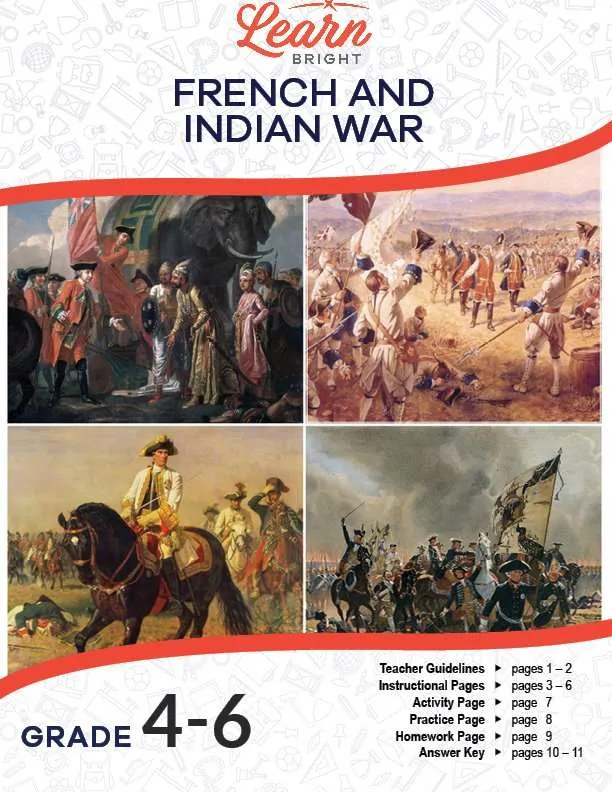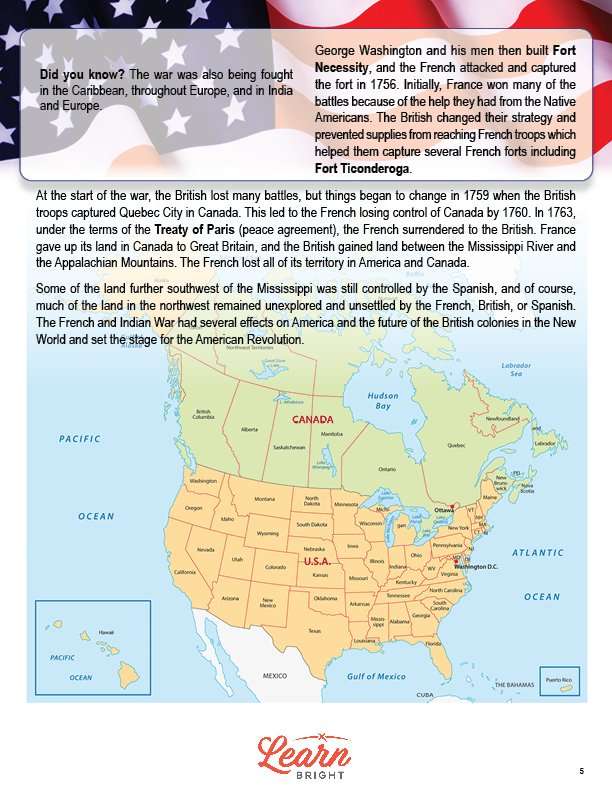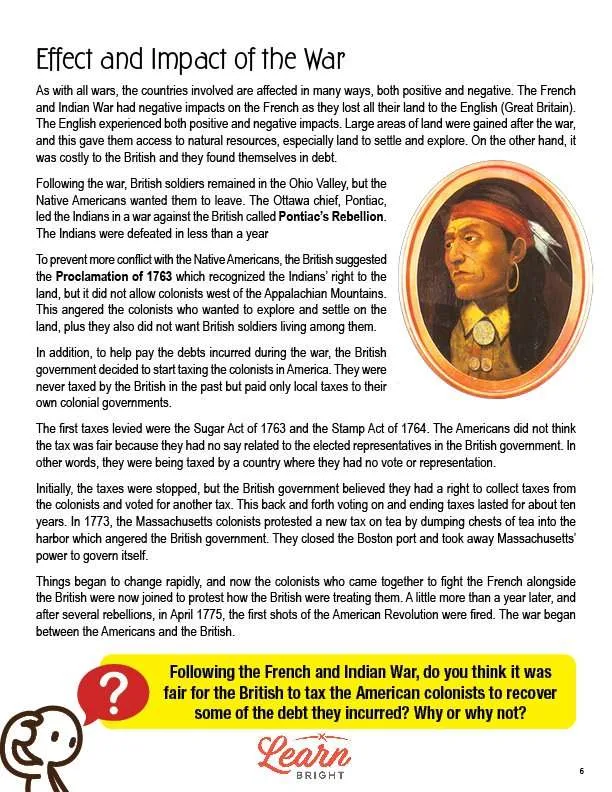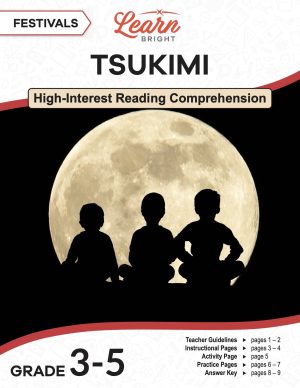Description
What our French and Indian War lesson plan includes
Lesson Objectives and Overview: French and Indian War teaches students about the causes, effects, and lasting impact of the French and Indian War. At the end of the lesson, students will be able to identify the cause of the French and Indian War, explain how it set the stage for the American Revolution, and describe the effects of the war on America. This lesson is for students in 4th grade, 5th grade, and 6th grade.
Classroom Procedure
Every lesson plan provides you with a classroom procedure page that outlines a step-by-step guide to follow. You do not have to follow the guide exactly. The guide helps you organize the lesson and details when to hand out worksheets. It also lists information in the orange box that you might find useful. You will find the lesson objectives, state standards, and number of class sessions the lesson should take to complete in this area. In addition, it describes the supplies you will need as well as what and how you need to prepare beforehand. The only supplies you will need for this lesson are the handouts.
Options for Lesson
Included with this lesson is an “Options for Lesson” section that lists a number of suggestions for activities to add to the lesson or substitutions for the ones already in the lesson. To add to the activity, you can include more questions. For an additional activity, you could have your students create a timeline of the French and Indian War. Finally, you could have your students create a map of North America showing land controlled by the British and French.
Teacher Notes
The teacher notes page includes a paragraph with additional guidelines and things to think about as you begin to plan your lesson. This page also includes lines that you can use to add your own notes as you’re preparing for this lesson.
FRENCH AND INDIAN WAR LESSON PLAN CONTENT PAGES
French and Indian War in America
The French and Indian War lesson plan includes four content pages. Over the past few hundred years, people have fought many different battles and wars on the land now known as the United States of America. Some of these include the Civil War, the Spanish-American War, the American Revolution, and a lesser-known war called the French and Indian War.
The British colonists and the French/Native Americans fought in the French and Indian War. Despite the name, the French and the Native Americans did not fight each other. The French and British fought, with Native American allies on both sides.
The French forged alliances with tribes like the Lenape, Ojibwa, Shawnee, Ottawa, and the Algonquin peoples. The British forged alliances with the Catawba, the Iroquois, and the Cherokee (for a brief period during the war). They fought most of this war in the northeastern part of the U.S. (before it was the U.S.), along the border between the British and French colonies in what they called New France.
The war began due to disagreements about settling the Ohio River Valley. Both the French and British colonists wanted to settle in the area. The French decided to start building forts to reinforce their claim on the land, but the British demanded that they leave anyway. The French refused and they started fighting over the land. This war lasted from 1756 to 1763. We sometimes also call it the Seven Years War.
Major Battles and Events
There were four major battles and events during the war. The first was at Fort Duquense in 1755, when British General Braddock led 1500 of his men to try to take the fort but was ultimately defeated. Next was the Massacre at Fort William Henry in 1757. The French attempted to take the fort and their Native American allies killed about 150 British soldiers during the fight. After that was the Battle of Quebec in 1759, where the British claimed a significant victory and occupied Quebec City. Finally, there was the Fall of Montreal in 1760. The city fell to the British. This marked the end period of the fighting in the American colonies.
The Conflict Begins
The French and Indian War really began when the American colonies started to expand west. The French moved into the Ohio River Valley and built Fort Duquesne on the Ohio River (where Pittsburgh, Pennsylvania is today). The British were mad that they’d built the fort. This led to the first battle of the war in 1755.
The French and British also fought this war in the Caribbean, in Europe, and in India. In the colonies, George Washington’s men build Fort Necessity, which the French captured in 1756. French won many of the early battles in the was because they had help from the Native Americans. Knowing this, the British decided to change tactics and stopped supplies from reaching the French. This helped them capture French forts like Fort Ticonderoga.
The British lost many battles at the start of this war. This changed starting in 1759, when they captured Quebec City in Canada. France lost control of Canada by 1760. In 1763, under the terms of the Treaty of Paris, the French surrendered. They gave up their land in Canada. The British also gained more land between the Mississippi River and the Appalachian Mountains. France lost all of its territory in Canada and America.
The Spanish still owned land southwest of the Mississippi. Most of the land in the northeast was unexplored by Europeans. The French and Indian War actually impacted the future of America and laid some of the groundwork for the American Revolution.
Effect and Impact of the War
The countries involved in this way were affected in both positive and negative ways. The French lost all of their land to the British. The British, on the other hand, saw both positive and negative impacts. They gained large areas of land, giving them access to more natural resources and land to settle. However, the war also put them into a great amount of debt.
After the war, the British soldiers stayed in the Ohio Valley. However, the Native Americans did not want them there. Pontiac, the Ottawa chief, led his people in a war against the British called Pontiac’s Rebellion. The British defeated them in less than a year.
The British wanted to avoid more conflict with the Native Americans and therefore suggested the Proclamation of 1763. This proclamation recognized the Native Americans’ right to the land and did not allow colonists west of the Appalachian Mountains. However, the colonists didn’t like this. They wanted to be able to settle that land and did not want British soldiers living among them.
The British also decided to start taxing their American colonies to help pay for the French and Indian War. The British had not taxed them before, and the colonists had only paid taxes to their local colonial governments.
The first taxes were the Sugar Act (1763) and the Stamp Act (1764). The settlers did not like these taxes and did not think they were fair because they had no representation in the British government. They were being taxes by a country without representation in that country’s government.
The British stopped the taxes initially but reinstated them because they believed they had the right to collect taxes from the colonists. They voted back and forth on these taxes for ten years. The Massachusetts colonists became fed up and, in 1773, protested a new tax on tea by throwing chests of tea into the Boston Harbor. This made the British government very angry and led them to close the Boston port and limit Massachusetts’ ability to govern itself.
This led to rapid change in the colonies, and the colonists (some of whom fought with the British during the French and Indian War) came together to fight the British. After several smaller rebellions, they fired the first shots of the American Revolution in April 1775.
Key Terms
Here is a list of the vocabulary words students will learn in this lesson plan:
- Seven Years War: Another name for the French and Indian War
- Fort Duquesne: The French built this fort to protect their claims
- Fort Necessity: Fort built by George Washington and his men; captured by the French
- Fort Ticonderoga: French fort captured by the British
- Treaty of Paris: A peace agreement between the French and British
- Pontiac’s Rebellion: A war against the British settlers led by Pontiac, the Ottawa chief
- Proclamation of 1763: A proclamation that recognized the Native Americans’ right to the land and did not allow colonists west of the Appalachian Mountains
FRENCH AND INDIAN WAR LESSON PLAN WORKSHEETS
The French and Indian War lesson plan includes three worksheets: an activity worksheet, a practice worksheet, and a homework assignment. You can refer to the guide on the classroom procedure page to determine when to hand out each worksheet.
DISCUSSION QUESTIONS ACTIVITY WORKSHEET
Students will work in groups to complete this activity. Each group will discuss and respond to four questions related to the lesson. After their discussion, each student will write down their personal response to each question. They will then participate in a full-class discussion.
Students may work either alone or in pairs for this activity.
FRENCH AND INDIAN WAR PRACTICE WORKSHEET
For the practice worksheet, students will answer 16 questions about the French and Indian War. This will help test their understanding of the lesson material.
SCENARIOS HOMEWORK ASSIGNMENT
The homework assignment asks students to the read four scenarios related to the French and Indian War and write a response to each.
Worksheet Answer Keys
This lesson plan includes answer keys for the practice worksheet and the homework assignment, though they note that some answers will vary from student to student. If you choose to administer the lesson pages to your students via PDF, you will need to save a new file that omits these pages. Otherwise, you can simply print out the applicable pages and keep these as reference for yourself when grading assignments.









